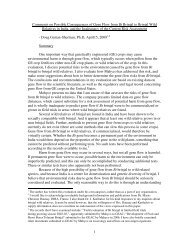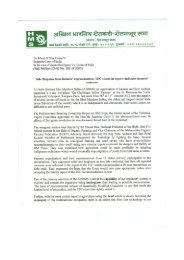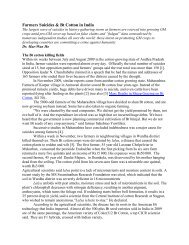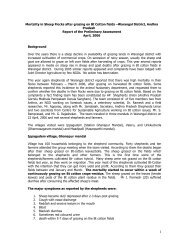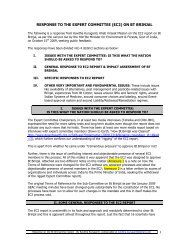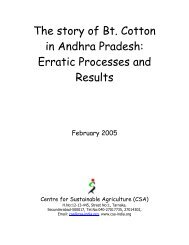A Decade of Bt cotton in Tamil Nadu - IndiaGMInfo
A Decade of Bt cotton in Tamil Nadu - IndiaGMInfo
A Decade of Bt cotton in Tamil Nadu - IndiaGMInfo
Create successful ePaper yourself
Turn your PDF publications into a flip-book with our unique Google optimized e-Paper software.
A DECADE OF BT COTTON IN TAMIL NADU 1<br />
BACKGROUND<br />
<strong>Bt</strong> <strong>cotton</strong> was <strong>of</strong>ficially approved for cultivation <strong>in</strong> <strong>Tamil</strong> <strong>Nadu</strong> <strong>in</strong> 2002, when the Genetic<br />
Eng<strong>in</strong>eer<strong>in</strong>g Approval Committee, the apex regulatory body perta<strong>in</strong><strong>in</strong>g to transgenics<br />
(renamed as Genetic Eng<strong>in</strong>eer<strong>in</strong>g Appraisal Committee <strong>in</strong> 2010) allowed three <strong>Bt</strong> <strong>cotton</strong><br />
hybrids to be cultivated <strong>in</strong> the southern zone <strong>of</strong> <strong>cotton</strong> cultivation <strong>in</strong> India.<br />
Interest<strong>in</strong>gly enough, the very first year’s monitor<strong>in</strong>g report from the state government<br />
<strong>of</strong> <strong>Tamil</strong> <strong>Nadu</strong> says that there is no yield difference between <strong>Bt</strong> <strong>cotton</strong> and non-<strong>Bt</strong><br />
<strong>cotton</strong>. It says, “it has been ascerta<strong>in</strong>ed that pesticide spray has been reduced <strong>in</strong> <strong>Bt</strong><br />
plots for Lepidoptera pests than <strong>in</strong> non <strong>Bt</strong> plots. Spray<strong>in</strong>g cont<strong>in</strong>ues for suck<strong>in</strong>g pests<br />
and prodenia. It is also a fact that due to severe drought, pest <strong>in</strong>cidence was low <strong>in</strong><br />
2002-03” 2 . There<strong>in</strong> lies a very pert<strong>in</strong>ent question, to be asked about each year’s<br />
performance: if the pest <strong>in</strong>cidence itself is low, can yield <strong>in</strong>creases <strong>in</strong> <strong>Bt</strong> <strong>cotton</strong> be<br />
attributed to the <strong>Bt</strong> technology or are there other factors which are to be studied? Very<br />
brief reports are presented from different districts <strong>in</strong> this monitor<strong>in</strong>g report from <strong>Tamil</strong><br />
<strong>Nadu</strong>, with a conclusion that says “there is no difference between <strong>Bt</strong> and non-<strong>Bt</strong> <strong>cotton</strong><br />
this year. It may be observed for two more years before a judgment is pronounced”.<br />
Thus began the story <strong>of</strong> <strong>Bt</strong> <strong>cotton</strong> <strong>in</strong> <strong>Tamil</strong> <strong>Nadu</strong>.<br />
Ironically however, the hype around the “success <strong>of</strong> <strong>Bt</strong> <strong>cotton</strong>” emerged from <strong>Tamil</strong><br />
<strong>Nadu</strong> too, along with other states throughout these ten years 3 . This report exam<strong>in</strong>es<br />
data available <strong>in</strong> <strong>of</strong>ficial records with regard to <strong>cotton</strong> cultivation <strong>in</strong> <strong>Tamil</strong> <strong>Nadu</strong> to try<br />
and see what is the real situation as per these <strong>of</strong>ficial records, the factors beh<strong>in</strong>d etc.<br />
COTTON IN TAMIL NADU<br />
Cotton, at present, is not a very important crop for <strong>Tamil</strong> <strong>Nadu</strong> <strong>in</strong> terms <strong>of</strong> production<br />
and is grown on a very small area, compared to the national <strong>cotton</strong> land acreage (TN<br />
hovers around 2% to 3% <strong>of</strong> India’s <strong>cotton</strong> land and frequently, less than that too, as<br />
<strong>cotton</strong> land is expand<strong>in</strong>g <strong>in</strong> other parts <strong>of</strong> the country). However, consumption <strong>of</strong> <strong>cotton</strong><br />
is the highest by the <strong>Tamil</strong> <strong>Nadu</strong> <strong>cotton</strong> mills amongst all states.<br />
Cotton <strong>in</strong> this state is cultivated <strong>in</strong> w<strong>in</strong>ter irrigated season (August-September), ra<strong>in</strong>fed<br />
season (September-October), summer irrigated (February-March) and on rice fallows<br />
(January-February). Nearly 45% <strong>of</strong> the crop cultivated is under irrigated conditions,<br />
which is a higher proportion than several other states and the national proportion. For<br />
<strong>cotton</strong> grown <strong>in</strong> ra<strong>in</strong>fed conditions, the quantum <strong>of</strong> South West monsoon ra<strong>in</strong>s has a<br />
significant <strong>in</strong>fluence.<br />
1<br />
This is a note based mostly on data from <strong>of</strong>ficial sources collected by Karthik<br />
Karthikeyan, compiled and written by Kavitha Kuruganti (kavitha.kuruganti@gmail.com), for<br />
Safe Food Alliance.<br />
2<br />
“Performance <strong>of</strong> <strong>Bt</strong> Cotton cultivation <strong>in</strong> <strong>Tamil</strong> <strong>Nadu</strong>”, Report <strong>of</strong> State Department <strong>of</strong><br />
Agriculture, http://moef.nic.<strong>in</strong>/divisions/csurv/geac/srtn.htm accessed on Nov. 4, 2011<br />
3 http://biospectrum<strong>in</strong>dia.ciol.com/content/CoverStory/20703072.asp is an example.<br />
1
The ma<strong>in</strong> districts that are <strong>in</strong>to <strong>cotton</strong> cultivation are Coimbatore, Dharmapuri, Erode,<br />
Madurai, Namakkal, Perambalur, Salem, Theni, Trichy, Vellore, Villupuram, Virudhunagar<br />
etc. About two lakh farmers are estimated to be <strong>in</strong>to <strong>cotton</strong> cultivation <strong>in</strong> <strong>Tamil</strong> <strong>Nadu</strong>, on<br />
average <strong>cotton</strong> farm hold<strong>in</strong>gs <strong>of</strong> 0.52 hectare each.<br />
The follow<strong>in</strong>g is the area, production and productivity-related data with regard to <strong>cotton</strong><br />
<strong>in</strong> <strong>Tamil</strong> <strong>Nadu</strong>, from 1996-97 to 2010-11, from the Cotton Corporation <strong>of</strong> India’s records.<br />
However, this data is not from <strong>in</strong>-the-season, farmer-field-based sources and is marketbased.<br />
The Yield data <strong>in</strong> that sense is questionable.<br />
<strong>Tamil</strong> <strong>Nadu</strong> Cotton Area, Production & Yield data<br />
Year Area Production Yield<br />
1996-97 2.60 5.50 3.60<br />
1997-98 2.47 5.00 3.44<br />
1998-99 2.43 5.50 3.85<br />
1999-00 1.85 5.50 5.05<br />
2000-01 1.93 5.50 4.84<br />
2001-02 2.00 5.00 4.25<br />
2002-03 0.85 3.00 6.00<br />
2003-04 1.03 3.75 6.19<br />
2004-05 1.29 5.50 7.25<br />
2005-06 1.40 5.00 6.68<br />
2006-07 1.00 5.00 8.50<br />
2007-08 0.99 4.00 6.87<br />
2008-09 1.09 5.00 7.80<br />
2009-10 1.04 5.00 8.17<br />
2010-11 1.30 5.00 6.54<br />
Source: http://cotcorp.gov.<strong>in</strong>/statistics.asp<br />
Another picture <strong>of</strong> Area (<strong>in</strong> thousands <strong>of</strong> hectares), Production (<strong>in</strong> thousands <strong>of</strong> bales,<br />
each bale be<strong>in</strong>g 170 kgs) and Yield (<strong>in</strong> kilos per hectare) is available from the<br />
Directorate <strong>of</strong> Economics and Statistics, through thousands <strong>of</strong> crop cutt<strong>in</strong>g experiments<br />
taken up by it. Irrigated <strong>cotton</strong> area ranged from 35% to 45% <strong>in</strong> different years.<br />
Year Area Production Yield<br />
1996-97 252.2 329.9 222<br />
1997-98 227.8 358 267<br />
1998-99 218.6 406.3 316<br />
1999-00 178.3 339.5 324<br />
2000-01 169.9 316.6 317<br />
2001-02 187.8 326.1 295<br />
2002-03 75.6 83.5 188<br />
2003-04 97.8 122.7 213<br />
2004-05 129.4 194.8 256<br />
2005-06 140.5 213.3 258<br />
2006-07 100.3 220.9 374<br />
2007-08 99.3 200.7 344<br />
Source: http://eands.dacnet.nic.<strong>in</strong>/StateData_12years.htm<br />
The above table shows some dramatic decl<strong>in</strong>es <strong>in</strong> land area under <strong>cotton</strong> cultivation <strong>in</strong><br />
<strong>Tamil</strong> <strong>Nadu</strong> start<strong>in</strong>g from the mid-1990s. The annual average yield <strong>in</strong> the six years<br />
preced<strong>in</strong>g the <strong>in</strong>troduction <strong>of</strong> <strong>Bt</strong> <strong>cotton</strong> was 290.17 kilos per hectare, while <strong>in</strong><br />
2
the six years after <strong>Bt</strong> <strong>cotton</strong>’s advent it was 272.17 kilos per hectare. Further,<br />
the data here do not reflect the dramatically high yield figures like the Cotton<br />
Corporation’s, probably because the CCI data relies on market sources for its<br />
<strong>in</strong>formation while the Directorate <strong>of</strong> Economics and Statistics relies on its own random<br />
crop cutt<strong>in</strong>g experiments.<br />
<strong>Bt</strong> COTTON IN TAMIL NADU<br />
Three <strong>Bt</strong> <strong>cotton</strong> hybrids with Monsanto’s proprietary technology were first allowed to be<br />
cultivated <strong>in</strong> <strong>Tamil</strong> <strong>Nadu</strong> <strong>in</strong> 2002, when an approval was provided for cultivation <strong>in</strong> the<br />
south zone states. In 2004, a <strong>Bt</strong> <strong>cotton</strong> hybrid <strong>of</strong> Raasi seeds was allowed. By 2010<br />
grow<strong>in</strong>g season, there were 444 <strong>Bt</strong> <strong>cotton</strong> hybrids/brands cover<strong>in</strong>g six genetic “events”<br />
from 35 companies that were on sale <strong>in</strong> South Zone <strong>in</strong>clud<strong>in</strong>g <strong>Tamil</strong> <strong>Nadu</strong>. However, it is<br />
worthwhile not<strong>in</strong>g that <strong>in</strong> <strong>Tamil</strong> <strong>Nadu</strong>, like elsewhere <strong>in</strong> the country, Monsanto’s<br />
proprietary technology related to <strong>Bt</strong> <strong>cotton</strong> has a monopolistic control over the seed<br />
market.<br />
The adoption <strong>of</strong> <strong>Bt</strong> <strong>cotton</strong> began grow<strong>in</strong>g dramatically <strong>in</strong> <strong>Tamil</strong> <strong>Nadu</strong> from 2005 grow<strong>in</strong>g<br />
season onwards and is estimated to have reached more than 95% by 2009.<br />
Area under <strong>Bt</strong> <strong>cotton</strong> hybrids <strong>in</strong> lakh hectares, over the years (the first year saw around<br />
3000 hectares planted to <strong>Bt</strong> <strong>cotton</strong>, <strong>in</strong> 2002-03) is presented <strong>in</strong> the table below.<br />
<strong>Bt</strong> Cotton expansion <strong>in</strong> <strong>Tamil</strong> <strong>Nadu</strong> (lakh hectares)<br />
Year Total Area <strong>Bt</strong> Cotton %age <strong>of</strong> total area<br />
2003-04 0.977 0.027 2.8<br />
2004-05 1.293 0.110 8.5<br />
2005-06 1.097 0.178 16.2<br />
2006-07 1.003 0.442 44.1<br />
2007-08 0.990 0.460 46.5<br />
2008-09 1.140 0.750 65.8<br />
2009-10 1.370 0.800 58.4<br />
Source: Report on Cotton Scenario and Implementation <strong>of</strong> M<strong>in</strong>i Mission II <strong>of</strong> Technology<br />
Mission on Cotton for the year 2009-2010, Department <strong>of</strong> Agriculture, <strong>Tamil</strong> <strong>Nadu</strong><br />
From the above table, it is clear that <strong>Bt</strong> <strong>cotton</strong> has not seen a steady expansion<br />
<strong>in</strong> <strong>cotton</strong> area <strong>of</strong> <strong>Tamil</strong> <strong>Nadu</strong> but actually saw a decl<strong>in</strong>e <strong>in</strong> 2009-2010, contrary<br />
to what <strong>in</strong>dustry data projects. Reasons for this are not apparent prima facie.<br />
SITUATION AFTER THE ADVENT OF BT COTTON<br />
The usual claims around <strong>Bt</strong> <strong>cotton</strong> are:<br />
• that yields will <strong>in</strong>crease, due to reduction <strong>in</strong> losses from pest attack ma<strong>in</strong>ly from<br />
bollworm complex (this pre-supposes pest <strong>in</strong>cidence s<strong>in</strong>ce there is no <strong>in</strong>tr<strong>in</strong>sic<br />
yield <strong>in</strong>crease potential from the <strong>Bt</strong> technology);<br />
• that pesticide use and costs will come down;<br />
• that costs <strong>of</strong> cultivation will reduce for farmers, improv<strong>in</strong>g their overall economic<br />
condition with such reduced costs and <strong>in</strong>creased yields.<br />
3
Yields<br />
It is also apparent that yields have been fluctuat<strong>in</strong>g <strong>in</strong> the state over the years, with or<br />
without <strong>Bt</strong> <strong>cotton</strong>, whether one looks at the Cotton Corporation <strong>of</strong> India data or the<br />
Directorate <strong>of</strong> Economics & Statistics’ data. The graph below shows that clearly.<br />
Source: Compiled from CCI and DACNET data<br />
In fact, any yield <strong>in</strong>creases until 2005-06 cannot be attributed to <strong>Bt</strong> <strong>cotton</strong> given that<br />
these seeds occupied a negligible portion <strong>of</strong> total <strong>cotton</strong> area <strong>in</strong> the state.<br />
Cost <strong>of</strong> cultivation, per hectare and per qu<strong>in</strong>tal<br />
Data on costs <strong>of</strong> cultivation is collected and put out by Directorate <strong>of</strong> Economics and<br />
Statistics, M<strong>in</strong>istry <strong>of</strong> Agriculture, Government <strong>of</strong> India. This is available at<br />
http://eands.dacnet.nic.<strong>in</strong>/Cost_<strong>of</strong>_Cultivation.htm for different crops, across states over<br />
the years.<br />
The follow<strong>in</strong>g data culled out from this source perta<strong>in</strong>s to Cost <strong>of</strong> Cultivation (C2,<br />
revised) per hectare and per qu<strong>in</strong>tal for Cotton <strong>in</strong> <strong>Tamil</strong> <strong>Nadu</strong>. The chart below also has<br />
the absolute cost mentioned <strong>in</strong> rupees each year.<br />
4
Source: Compiled from http://eands.dacnet.nic.<strong>in</strong>/Cost_<strong>of</strong>_Cultivation.htm<br />
It is apparent from this data perta<strong>in</strong><strong>in</strong>g to <strong>Tamil</strong> <strong>Nadu</strong> that neither the per-hectare cost<br />
<strong>of</strong> cultivation nor the per-qu<strong>in</strong>tal cost <strong>of</strong> cultivation have steadily come down as <strong>Bt</strong><br />
<strong>cotton</strong> area expanded, as promised and claimed. While present<strong>in</strong>g this data, it is<br />
assumed that this data would have evolved from <strong>Bt</strong> <strong>cotton</strong> farmers too, given that<br />
sampl<strong>in</strong>g for this happens <strong>in</strong> a random manner and given that <strong>Bt</strong> <strong>cotton</strong> expansion is<br />
reported to be high <strong>in</strong> the recent years with<strong>in</strong> the <strong>cotton</strong> area <strong>of</strong> the state.<br />
Volume <strong>of</strong> Chemical Pesticides’ Usage <strong>in</strong> Cotton <strong>in</strong> <strong>Tamil</strong> <strong>Nadu</strong><br />
The NALMOT report on Cotton Scenario for 2007-08 has some data on major chemical<br />
pesticides used <strong>in</strong> <strong>cotton</strong> by volume and categories, as presented below.<br />
Major Chemical Pesticides Used <strong>in</strong> Cotton, <strong>in</strong> Metric Tonnes (Technical Grade)<br />
Category 2003-04 2004-05 2005-06 2006-07 2007-08<br />
Insecticides 14.18 15.3 14.16 15.12 14.0<br />
Fungicides 7.04 4.50 3.75 3.75 3.00<br />
Others 4.25 3.88 3.81 3.50 3.00<br />
Source: NALMOT visit report on Cotton Scenario and Implementation <strong>of</strong> M<strong>in</strong>i Mission II <strong>of</strong><br />
Technology Mission on Cotton for the year 2008-2009, Dept <strong>of</strong> Agriculture, <strong>Tamil</strong> <strong>Nadu</strong><br />
It is important to note that <strong>in</strong>secticides usage, which is supposed to come down with the<br />
use <strong>of</strong> <strong>Bt</strong> <strong>cotton</strong> has not shown any significant difference even as <strong>Bt</strong> <strong>cotton</strong> expanded to<br />
larger areas over the years.<br />
5
Fertiliser & Pesticide costs <strong>in</strong> Cotton Cultivation <strong>in</strong> <strong>Tamil</strong> <strong>Nadu</strong><br />
Source: Directorate <strong>of</strong> Economics & Statistics, MoA, GoI<br />
From the graph above, it appears that per hectare costs on pesticides were not always<br />
very high, as rationalized dur<strong>in</strong>g the approval given to <strong>Bt</strong> <strong>cotton</strong>. In 2000-01, for<br />
<strong>in</strong>stance, two years before <strong>Bt</strong> <strong>cotton</strong> was approved, it was just Rs. 558/- per hectare <strong>in</strong><br />
<strong>Tamil</strong> <strong>Nadu</strong> and even after the advent <strong>of</strong> <strong>Bt</strong> <strong>cotton</strong>, this low amount was not rega<strong>in</strong>ed<br />
when it came to farmers’ spend<strong>in</strong>g on pesticides. Compared to Rs. 1034/- per hectare<br />
on pesticides when <strong>Bt</strong> <strong>cotton</strong> was 44% <strong>of</strong> the <strong>cotton</strong>, the spend<strong>in</strong>g went up to Rs.<br />
1383/- per hectare when it reached 66% adoption as per <strong>of</strong>ficial records (more than<br />
70% by <strong>in</strong>dustry figures).<br />
In recent years, spend<strong>in</strong>g on chemical fertilizers for <strong>cotton</strong> cultivation appears to be<br />
go<strong>in</strong>g up, with the exception <strong>of</strong> 2007-08, <strong>in</strong> the state.<br />
Shift from <strong>cotton</strong> varieties to <strong>cotton</strong> hybrids over the years<br />
There has been a dramatic shift away from <strong>cotton</strong> varieties like MCU5 VT, LRA5166,<br />
Surabhi, SVPR3, K11, MCU7 to <strong>Bt</strong> <strong>cotton</strong> hybrids <strong>in</strong> the state as depicted <strong>in</strong> the graph<br />
below. This data is obta<strong>in</strong>ed from the NALMOT report <strong>of</strong> 2009-2010. It is very apparent<br />
that such a shift is not discussed while talk<strong>in</strong>g about yield <strong>in</strong>creases, if any. It can be<br />
seen from the data and the graph that <strong>cotton</strong> varieties, which occupied nearly half <strong>of</strong><br />
the sown <strong>cotton</strong> area <strong>in</strong> 2005-06, came down by 67% by 2009-2010. Varieties occupied<br />
only 12% <strong>of</strong> the <strong>cotton</strong> area <strong>in</strong> 2009-2010. In 2008-09, varieties were only 17% <strong>of</strong> the<br />
<strong>cotton</strong> area. This shift has implications potentially <strong>in</strong> terms <strong>of</strong> yield <strong>in</strong>creases but also <strong>in</strong><br />
terms <strong>of</strong> more <strong>in</strong>vestments required <strong>of</strong> farmers, <strong>in</strong>creas<strong>in</strong>g their seed dependency on<br />
external sources and therefore, creat<strong>in</strong>g a new cause for crisis related to seed choices,<br />
seed prices and seed sovereignty. For <strong>in</strong>stance, “seed shortages” have been reported<br />
from different states <strong>of</strong> India earlier <strong>in</strong> 2011, br<strong>in</strong>g<strong>in</strong>g farmers onto the streets agitat<strong>in</strong>g<br />
6
for timely supply <strong>of</strong> seed and black market<strong>in</strong>g <strong>of</strong> seeds was reported widely. It has to be<br />
remembered however that such ‘shortages’ disappeared dramatically once the sow<strong>in</strong>g<br />
season began, reflect<strong>in</strong>g how the seed <strong>in</strong>dustry is not averse to play<strong>in</strong>g with the lives <strong>of</strong><br />
farmers for their own pr<strong>of</strong>iteer<strong>in</strong>g!<br />
Major failures <strong>of</strong> crop <strong>in</strong> recent years<br />
In November 2005, follow<strong>in</strong>g reports <strong>of</strong> seed germ<strong>in</strong>ation failure from Salem and<br />
Namakkal districts, a civil society fact f<strong>in</strong>d<strong>in</strong>g team called the “Monitor<strong>in</strong>g and Evaluation<br />
Committee” went <strong>in</strong>to the field to <strong>in</strong>vestigate and found after <strong>in</strong>teract<strong>in</strong>g with seed<br />
dealers, <strong>of</strong>ficials and farmers, confirmed that there has been a germ<strong>in</strong>ation failure <strong>of</strong><br />
upto 75% <strong>in</strong> at least 35% <strong>of</strong> the area sown <strong>in</strong> Salem and Namakkal districts 4 . The fact<br />
f<strong>in</strong>d<strong>in</strong>g report po<strong>in</strong>ted out that while the failure <strong>of</strong> germ<strong>in</strong>ation is be<strong>in</strong>g attributed to<br />
excessive ra<strong>in</strong>fall, such a failure was not found <strong>in</strong> the non-<strong>Bt</strong> <strong>cotton</strong> fields <strong>of</strong> the same<br />
farmers. It was seen that seeds <strong>of</strong> Raasi and to an extent, Mahyco, had failed to<br />
germ<strong>in</strong>ate. Due to repeated sow<strong>in</strong>gs, farmers ended up shell<strong>in</strong>g out nearly Rs.<br />
3500/acre on seeds alone that season. It is unclear if any compensation has been paid<br />
to the affected farmers to this day; the regulators and the state government discounted<br />
seed failure <strong>in</strong> this case.<br />
In January 2007, there were reports aga<strong>in</strong> <strong>of</strong> <strong>cotton</strong> crop failure <strong>in</strong> <strong>Tamil</strong> <strong>Nadu</strong> 5 . This<br />
time, it was the turn <strong>of</strong> farmers <strong>in</strong> Dharmapuri who suffered with Mahyco’s <strong>Bt</strong> <strong>cotton</strong><br />
seed. In this case, after scientists and agriculture department <strong>of</strong>ficials <strong>in</strong>vestigated the<br />
failure reports, this was confirmed by the <strong>Tamil</strong> <strong>Nadu</strong> Agriculture M<strong>in</strong>ister at that time as<br />
a problem caused by improper seeds. It was reported that the M<strong>in</strong>ister had ordered that<br />
the said company should not sell any type <strong>of</strong> seeds <strong>in</strong> <strong>Tamil</strong> <strong>Nadu</strong> and had asked for the<br />
affected farmers to be compensated.<br />
4 Gargi Parsai, “<strong>Bt</strong> <strong>cotton</strong> seeds fail to germ<strong>in</strong>ate”, The H<strong>in</strong>du, November 10 th , 2005.<br />
http://www.h<strong>in</strong>du.com/2005/11/10/stories/2005111007110500.htm<br />
5 “<strong>Bt</strong> <strong>cotton</strong> crop fails <strong>in</strong> <strong>Tamil</strong> <strong>Nadu</strong>”, January 5 th , 2007.<br />
http://www.f<strong>in</strong>ancialexpress.com/news/story/188798/<br />
“<strong>Tamil</strong> <strong>Nadu</strong> blacklists Mahyco’s <strong>Bt</strong> <strong>cotton</strong> seeds after crop failure”, Down To Earth,<br />
15/2/2007. http://www.downtoearth.org.<strong>in</strong>/node/5514<br />
7
In January 2009, another <strong>in</strong>stance <strong>of</strong> failure <strong>of</strong> <strong>Bt</strong> <strong>cotton</strong> emerged – from Erode district<br />
now 6 . The redden<strong>in</strong>g <strong>of</strong> the leaves and lodg<strong>in</strong>g <strong>of</strong> plants <strong>in</strong> this case <strong>of</strong> failure was<br />
blamed on magnesium deficiency by <strong>in</strong>vestigat<strong>in</strong>g scientists even though no samples<br />
were taken for test<strong>in</strong>g. Farmers harvested very low yields and <strong>in</strong>curred economic losses.<br />
It is known <strong>in</strong>formally that some compensation has been paid to some <strong>of</strong> the affected<br />
farmers while details are unclear on this front; however, it is clear that there are no<br />
liability mechanisms <strong>in</strong> place for redressal and accountability.<br />
In a Round Table organized <strong>in</strong> Bengalooru on March 26 th and 27 th 2011 by SAGE<br />
(Southern Action on Genetic Eng<strong>in</strong>eer<strong>in</strong>g), two farmers from <strong>Tamil</strong> <strong>Nadu</strong> presented their<br />
bitter experiences with <strong>Bt</strong> <strong>cotton</strong> <strong>in</strong> front <strong>of</strong> a panel <strong>of</strong> 4 senior High Court Judges.<br />
Source: Extracted from “What are the South Indian Farmers say<strong>in</strong>g about their <strong>Bt</strong><br />
Cotton experience?”, SAGE, April 2011. PP 12<br />
6 Kannaiyan, “Failure <strong>of</strong> Monsanto’s <strong>Bt</strong> <strong>cotton</strong>”, May 12 th 2009.<br />
http://kannaiyan.blogspot.com/2009/05/normal-0-false-false-false-en-<strong>in</strong>-x-none.html<br />
http://www.theh<strong>in</strong>du.com/2009/01/31/stories/2009013156960600.htm,<br />
http://www.h<strong>in</strong>du.com/2009/02/03/stories/2009020352740300.htm,<br />
http://www.h<strong>in</strong>du.com/2009/02/04/stories/2009020451260300.htm,<br />
http://www.h<strong>in</strong>du.com/2009/03/17/stories/2009031754890500.htm<br />
8
Source: Extracted from “What are the South Indian Farmers say<strong>in</strong>g about their <strong>Bt</strong><br />
Cotton experience?”, SAGE, April 2011. PP 13<br />
9
In this Round Table, the em<strong>in</strong>ent panel <strong>of</strong> Judges made a number <strong>of</strong> observations based<br />
on the experiences <strong>of</strong> farmers from different states, concern<strong>in</strong>g the false claims and<br />
promises held out, exorbitant seed costs, large scale losses <strong>of</strong> crop, adverse effects on<br />
the cultivation <strong>of</strong> traditional <strong>cotton</strong>, adverse health impacts, impacts on cattle, human<br />
food cha<strong>in</strong> contam<strong>in</strong>ation with <strong>cotton</strong> seed oil, adverse effects on soil, <strong>in</strong>crease <strong>in</strong> pest<br />
<strong>in</strong>cidence, non-availability <strong>of</strong> traditional <strong>cotton</strong> seeds and so on.<br />
TO SUM UP<br />
• <strong>Bt</strong> <strong>cotton</strong> expansion <strong>in</strong> <strong>Tamil</strong> <strong>Nadu</strong> did not <strong>in</strong>crease <strong>in</strong> steady yield <strong>in</strong>creases as<br />
claimed and hyped up. <strong>Tamil</strong> <strong>Nadu</strong> had high yields <strong>in</strong> <strong>cotton</strong> even <strong>in</strong> the years<br />
when it predom<strong>in</strong>antly grew non-<strong>Bt</strong> varieties (not even hybrids).<br />
• <strong>Bt</strong> <strong>cotton</strong> cultivation <strong>in</strong> larger areas did not br<strong>in</strong>g down the per-hectare or per<br />
qu<strong>in</strong>tal cost <strong>of</strong> cultivation as projected. The trends on this front have always<br />
been fluctuat<strong>in</strong>g and this cont<strong>in</strong>ues.<br />
• <strong>Bt</strong> <strong>cotton</strong> cultivation and expansion to larger areas did not br<strong>in</strong>g down the<br />
<strong>in</strong>secticide usage <strong>in</strong> <strong>cotton</strong> crop <strong>in</strong> <strong>Tamil</strong> <strong>Nadu</strong>. Further, <strong>Tamil</strong> <strong>Nadu</strong> had low<br />
average cost <strong>in</strong>curred on pesticides (<strong>in</strong>dicative <strong>of</strong> lower use <strong>in</strong> volume too) even<br />
prior to <strong>Bt</strong> <strong>cotton</strong> <strong>in</strong>troduction and the rationale for its approval is not clear <strong>in</strong><br />
such a context. Spend<strong>in</strong>g on chemical fertilizers appears to be on an upward<br />
trend <strong>in</strong> <strong>cotton</strong> cultivation now.<br />
• There has been a large scale shift away from <strong>cotton</strong> varieties to sow<strong>in</strong>g <strong>of</strong> <strong>Bt</strong><br />
<strong>cotton</strong> hybrids rais<strong>in</strong>g many serious concerns around seed choices, seed prices<br />
and seed sovereignty, <strong>in</strong> addition to <strong>in</strong>creas<strong>in</strong>g chemicalisation <strong>of</strong> agriculture.<br />
This also raises valid questions on why <strong>Bt</strong> technology is seen as the cause for<br />
<strong>cotton</strong> yield <strong>in</strong>creases, even by scientific <strong>in</strong>stitutions like the <strong>Tamil</strong> <strong>Nadu</strong><br />
Agricultural University; this is all the more perplex<strong>in</strong>g <strong>in</strong> a context when pest<br />
<strong>in</strong>cidence itself is reported low!<br />
• There have been major failures <strong>of</strong> <strong>Bt</strong> <strong>cotton</strong> crop over the years and the<br />
unpredictability <strong>of</strong> performance is apparent from this. However, farmers have not<br />
always obta<strong>in</strong>ed a redressal from such failures. There are serious questions<br />
around the lack <strong>of</strong> a liability regime which covers both penalties as well as<br />
compensation <strong>in</strong> addition to remediation where necessary.<br />
10



